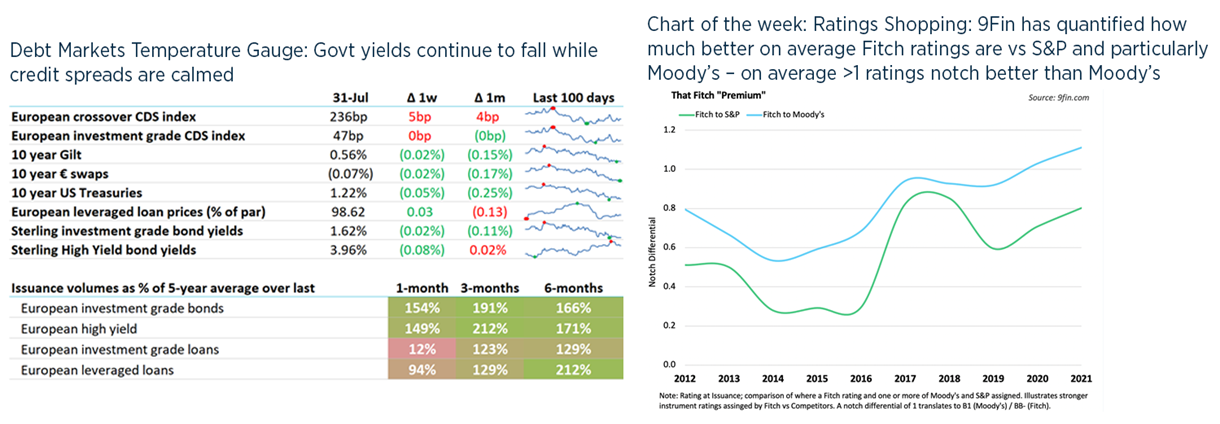-
BackWhat we doNumis is an ambitious, dynamic and innovative investment bank, driven to excel across all aspects of its delivery.Investment Banking
-
BackLatest newsRead the latest news about our business, our people and our work, find out about our next events and conferences.News
-
BackWho we areOur collaborative environment and distinctive way of excelling , is nothing without our great people.
-
BackOur board
Debt Advisory Weekly
There’s been a short hiatus in our weeklies due to annual leave / Robyn’s marriage and a few deals.
We’d like a quick boast about two Debt Advisory deals for which we recently arranged over $600m of debt, each alongside an equity raise where Numis acted as Bookrunner.

1. Auction Technology Group’s $525m acquisition of LiveAuctioneers: we put in place $253m of 5-year acquisition debt facilities for the combined group, through a new bank club, all of which were new relationships.
2. Learning Technologies Group’s $400m acquisition of GP Strategies: we arranged $355m of debt (mostly 5-year), again arranged through a new bank club.
Key points: we put together a bank club so there was no need for underwriting fees / syndication risk; start-to-finish in both cases was less than 6 weeks; both borrowers achieved significantly more flexibility than their previous facilities – despite being much bigger and more leveraged; 5-year deals are firmly back on the menu.
To complete the similarities, both borrowers are delighted with the outcome and are happy to recommend us to any borrowers who need some debt advice.
More deals on the way soon.
TL / DR: losing more than you lend; make-wholes; penalty box
1. Profit Given Default?
- To decide how much capital to set against a loan, banks have to work out their “expected loss” – a probability-weighted expectation of how much they might lose.
- Three key drivers: (i) how big is the loan, (ii) how likely the borrower is to default, and (iii) how much the banks will lose in the bankruptcy process after a default.
- In bank-speak, this is “Exposure at Default”, “Probability of Default” and “Loss Given Default”.
- The most unknowable is the probability of default. You don’t get a reliable answer by asking the borrower so banks estimate / make a guess using a combination of fundamental analysis of competitive position, financial metrics and market signals like equity prices.
- Exposure At Default for a term loan is easy but harder for undrawn loans. Historically, banks often assumed any undrawn commitments would be 40-50% drawn further at default (on average).
- Maybe the rush for borrowers to draw their facilities in full last Spring might push this assumption upwards in future, increasing capital intensity of RCFs?
- Finally, we reach Loss Given Default (LGD) or its inverse, Recovery Rating. While you never know exactly how much you would recover from insolvency, surely it can only be between 0% and 100%? Except …
- In the US recently, a mall outside Las Vegas lost >95% of its value and sold for $400,000 when the loan balance was $62m. Unfortunately, the borrower had also incurred $12m in fees etc which means that the Loss Given Default was 120% of amount borrowed.
- We were also talking to a direct lender recently who last year repossessed a business that had been hit by COVID, bad management and bad ownership. However, the good news is that this year, having turned it around, they expect to sell soon for more than the original loan – a ‘Profit Given Default’?
- A similar situation might transpire in Caffe Nero where the Court heard that EG has taken a controlling position in the junior debt, not as a loan to own but as a sign of their commitment to the business.
2. Lord Spens Makes You Whole
- For a fixed rate bond, market practice is that early repayment requires a “make-whole” payment – a premium above the amount borrowed to ‘compensate’ the bondholder from receiving the cash back earlier than anticipated.
- Floating rate loans don’t normally have this and are typically repayable at par or perhaps 101-102% of par for the first coupon of years.
- In principle, the ‘make-whole’ payment is the amount which would produce similar cash flows as those that would have been received under the original loan. Economically, the way to do is to ensure the Present Value of the future coupons remains the same. But, like with pension deficits, which discount rate to use is key.
- At its simplest, if the discount rate is zero then investors would receive all future coupons and principal. A higher discount rate means a lower make-whole.
- The original thinking behind this is that investors had expected to receive the future coupons and principal, maybe matching their own liabilities to pensioners. If they are repaid and will not receive these future coupons then they need to reinvest the repayment proceeds to replicate this stream – and there may not be an appropriate reinvestment opportunity. But there always is the ability to buy Gilts.
- Because Gilt yields are always lower than other bonds, the repayment proceeds are increased so that the investor can buy enough Gilts to get the same future stream of coupons – this is done by using the Gilt yield to discount the future bond coupons to produce the amount of redemption proceeds.
- Given Gilts are risk-free, after a repayment investors are effectively being paid the credit spread without taking credit risk.
- This premium is typically negotiated so that a higher yield is used (known as ‘modified make-whole’) e.g. 0.50% to 1% above government yield. This mechanic is now enshrined in FCA regulation.
- At today’s rates, for a 10-year bond redeemed in year 5, this means a make-whole price of about 105%.
- A banker recently to me that I loved a piece of financial scandal or bad behaviour and it’s true. So I can’t let this pass without noting that the formulation above is known as Spens Clause, named after Lord Spens, the 3rd Baron Spens of Blairsanquhar, who first came up with the idea in the 1970s. I believe this is the same Spens who was wrongly prosecuted and acquitted of abetting Ernest Saunders in the Guinness affair. Saunders incidentally is the only known human to have apparently recovered from Alzheimers, which gives me hope as I contemplate my mother’s dementia.
- The first American bond to have a make-whole is apparently Domtar Inc in 1987; I’m still looking for Lord Spens’s work in the 1970s – any pointers welcomed.
3. In and out of the penalty box
- One month on, perhaps we are now able to talk again about penalties, this time for bad behaviour in the fixed income markets.
- I enjoyed how briefly the EU put some banks in the naughty corner for their behaviour in the bond markets.
- The EU found 7 banks had been running a cartel in EU sovereign bonds between 2007 and 2011, including NatWest and Bank of America Merrill Lynch. 3 of the banks were fined €371m in total but NatWest escaped as it been the whistleblower.
- In further action, the EU barred these banks from acting as bookrunners for its €20bn deal in June, which must have made for an awkward weekend for those running the government desks at those banks as the EU is gearing up to issue €800bn of bonds for its NextGenerationEU recovery fund.
- Fortunately, the EU re-admitted those banks after just three days in the penalty box after they provided a “declaration of honour”, promised to “act with integrity” and take remedial actions.
- This is very like my own parenting when I confiscate an iphone “forever” only to relent and give it back the next day after they promise to be good from now on. I put my own softness and inconsistency to an excess of love for my children – is this how the EU feels towards its banks?
UK Financings this month
- Obviously the best-structured deals were acquisition facilities for Auction Technology Group ($253m) and Learning Technologies Group raising ($355m) in June and July – contact us to hear more about how we saved our clients money and beat some very demanding timetables.
- Saga rebooted its debt capital structure with a new £250m 5-year HY at 5.5% to add liquidity and repay £100m of existing bonds, as well as extending its loan facilities.
- Breedon completed a refinancing with £250m-eq in the EUR and GBP private placement market, at 2.1-2.4% in £ and 1.1-1.3% in €. It was suggested that Breedon used a more competitive process so that it could achieve coupons about 0.5% less than Biffa had managed in May – hard to prove this though.
- Punch completely refinanced its ancient creaking securitisation with a £600m 5-year HY at 6.125% - showing how high yield investors are more willing to take credit risk than structured finance investors.
- Pizza Express refinanced with a £335m 5-year at 6.75% through Goldman Sachs, taking out the liquidity loan that HPS provided in March 2020.
- Entain priced a $1.125bn loan at L+250bp with a 0.5% floor at 99.75 OID to refinance and extend existing debt.
- SigmaROC entered into £305m of facilities with Santander and BNPP for onward distribution for its acquisition of Nordkalk.
- Fortress has lined up £5.75bn for its agreed bid for Morrisons, provided by HSBC and RBC. About £3bn will be distributed into the leveraged loan / HY markets. I think there is more to come here …
- Constellation Automotive Group (BCA) refinanced with £875m of leveraged loans and £325m 2nd lien note, which priced at L+400bp and L+750bp respectively, alongside a new 6-year £695m HY paying 4.875%. This comes after it raised £1bn from investors such as Abu Dhabi.
- S4 Capital raised €375m at E+400bp to refinance.
- Stonegate raised another £165m of high yield bonds at 7.23%, meaning it’s raised almost £2bn of debt over the past year (TDR has injected some more equity too).
- In another example of the HY market forgiving issuers, The Very Group (Shop Direct / Littlewoods) priced £575m of 5-year bonds at 6.5% (wide end of pricing); this high coupon was driven partly by history (Very gave the market a shock on PPI two years ago) and also the ability to repay 100% from an IPO at a price of 102 – very off-market and which could cap returns for HY investors.
Our services
Numis is an ambitious, dynamic and innovative investment bank, driven to excel across all aspects of its delivery.




